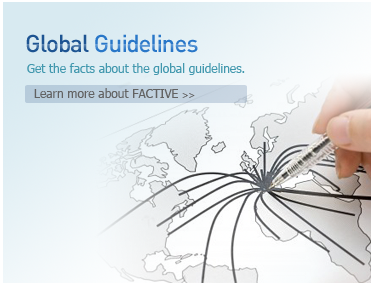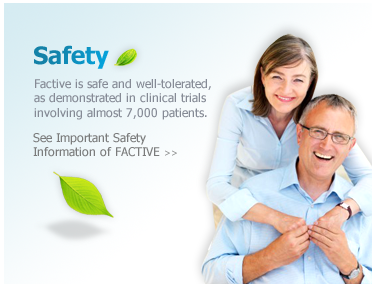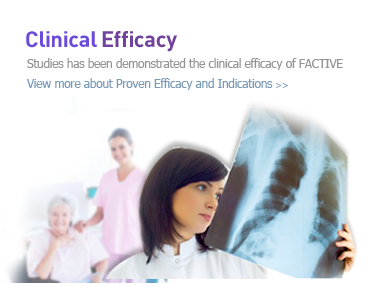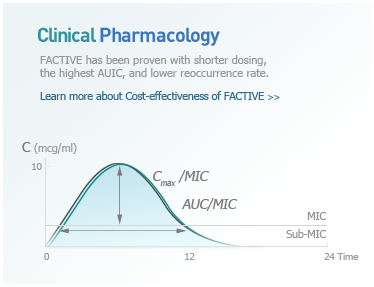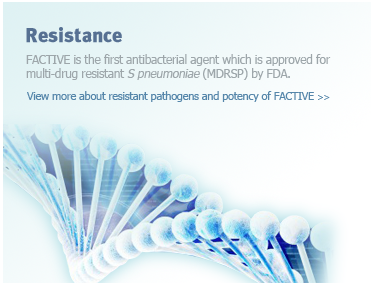With the prevalence of resistant pathogens increasing, Factive meets an urgent need for powerful first-line therapy with proven clinical success in patients infected with resistant pathogens. FACTIVE is the first antibiotic FDA-approved to treat MDRSP and is the most potent quinolone in vitro and demonstrated clinical success in 86.4% of patients infected with MDRSP.
FACTIVE is a functionally dual targeting quinolone. FACTIVE is called an enhanced affinity quinolone as its in vitro IC50 (i.e. the concentration at which it inhibits enzymatic activity by 50%) is markedly lower than that of other quinolones Therefore, FACTIVE has lowest mutant rate of both Topoisomerase IV and DNA gyrase, causing lowest resistant rate.
FACTIVE has in vitro activity against a wide range of Gram-positive, Gram-negative and atypical microorganisms clinically relevant to respiratory tract infections.
FACTIVE is rapidly absorbed after oral administration, achieving its peak plasma concentration around 1 hour after dosing. Dosage adjustments are unlikely to be necessary in patients with mild-to moderate renal or hepatic impairment. Due to shorter regimen, the highest AUIC, and lower reoccurrence rate, some studies proved that FACTIVE is cost-effective.
FACTIVE is available in oral 320 mg doses, with recommended regimens of 3 to 7 days depending on the indication and dosing strength. FACTIVE is also effective in shorter courses than many other antibiotics due to its rapid bactericidal action.
The potent activity of FACTIVE against bacterial pathogens frequently responsible for respiratory tract infections suggests its potential for the treatment of several types of infection. In some countries, besides respiratory tract infections, FACTIVE has been approved with other indications. For more information, please see the full prescribing information on the “Global countries” tab.
Comprehensive safety data collected from >8000 patients treated with FACTIVE in clinical trials and >15,000 patients treated with FACTIVE in postmarketing and phase IV studies demonstrate that FACTIVE is generally well tolerated with a frequency of side effects comparable to comparator antibiotics.
Safety Profile Drug Interactions Special warnings and precautions
Find a comprehensive view of practice guidelines on the treatment of bacterial RTIs, UTIs, and Hospital infections. Guidelines may not account for individual variations among patients or present complete information for drug products; and are not intended to replace good clinical judgment.
Review published literature on the management of bacterial infections, microbiology, pharmacology, Safety of FACTIVE.
Important Safety Information
THE SAFETY AND EFFECTIVENESS OF FACTIVE IN CHILDREN, ADOLESCENTS (<18 YEARS OF AGE), PREGNANT WOMEN, AND LACTATING WOMEN HAVE NOT BEEN ESTABLISHED.
FACTIVE is contraindicated in patients with a history of hypersensitivity to gemifloxacin, fluoroquinolone antibiotic agents, or any of the product components. Serious hypersensitivity and/or anaphylactic reactions have been reported in patients receiving fluoroquinolone therapy, including FACTIVE. Hypersensitivity reactions reported in patients receiving fluoroquinolone therapy have occasionally been fatal. These reactions may include serious, sometimes fatal skin reactions such as toxic epidermal necrolysis or Stevens-Johnson Syndrome; effects on the liver, including hepatitis, jaundice, and acute hepatic necrosis or failure; renal toxicities including interstitial nephritis and/or acute renal insufficiency or failure; and hematologic effects, including agranulocytosis, thrombocytopenia, and other hematologic abnormalities. These reactions may occur following the first dose or multiple doses. FACTIVE should be discontinued immediately at the first sign of an immediate type I hypersensitivity skin rash or any other manifestation of hypersensitivity reaction.
Fluoroquinolones, including FACTIVE, are associated with an increased risk of tendinitis and tendon rupture in all ages. This risk is further increased in older patients usually over 60 years of age, in patients taking corticosteroid drugs, and in patients with kidney, heart, or lung transplants. Call your healthcare professional right away at the first sign of tendon pain, swelling, or inflammation. You should stop taking FACTIVE until tendinitis or tendon rupture have been ruled out, and avoid exercise and using the affected area.
Fluoroquinolones may prolong the QT interval in some patients. FACTIVE should be avoided in patients with a history of prolongation of the QTc interval, patients with uncorrected electrolyte disorders (hypokalemia or hypomagnesemia), and patients receiving Class IA or Class III antiarrhythmic agents.
Rare cases of peripheral neuropathy have been reported in patients receiving quinolones.
In clinical studies with FACTIVE, central nervous system (CNS) effects have been reported infrequently. As with other fluoroquinolones, FACTIVE should be used with caution in patients with known or suspected CNS diseases. If CNS reactions occur, FACTIVE should be discontinued and appropriate measures instituted.
Clostridium difficile associated diarrhea (CDAD) has been reported with use of nearly all antibiotic agents, including FACTIVE. If diarrhea occurs, evaluate for CDAD and treat appropriately.
In clinical trials, rash occurred more often with FACTIVE than therapy with comparator agents (2.8% vs. 0.6%). Increasing incidence of rash was associated with younger age (especially below 40), female gender, use of hormone replacement therapy, and longer duration of therapy.
Moderate to severe photosensitivity/phototoxicity reactions can be associated with the use of quinolones after sun or UV light exposure. Excessive exposure to the sun or UV light should be avoided.
Magnesium- and/or aluminum-containing antacids, products containing ferrous sulfate (iron), multivitamin preparations containing zinc or other cations, or Videx® (didanosine) chewable/buffered tablets or the pediatric powder for oral solution should not be taken within 3 hours before or 2 hours after FACTIVE. Sucralfate should not be taken within 2 hours of FACTIVE.
In clinical trials, the most common adverse drug reactions (≥2%) were diarrhea, rash, nausea, headache, abdominal pain, vomiting, and dizziness.
This product is available by prescription only.
* Videx® is a registered trademark of Bristol-Myers Squibb Company.
For US residents,
You are encouraged to report negative side effects of prescription drugs to the FDA. Visit www.fda.gov/medwatch, or call 1-800-FDA-1088.
For Non-US residents,
You are encouraged to report negative side effects of prescription drugs, please click here or call 82-2-6924-3620.
Please note that the information contained on this site is intended for international health care providers and may not be appropriate for your country of origin. Please see the full FACTIVE prescribing information for your country for approved product indications, dosing, and important safety considerations. Click on the "Global Countries" tab above to learn how to obtain country-specific prescribing information.







